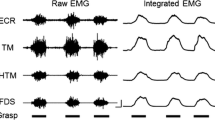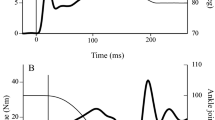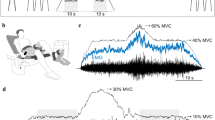Summary
Reflex stiffness of the flexing human index finger was studied using sinusoidal movements at 3–16 Hz. The Nyquist stiffness diagram indicates the presence of a ‘presonance’ at around 4 Hz, its ‘C’ shape after correction for the mechanical properties of the relaxed finger is consistent with the involvement of a stretch reflex in its generation. This contention was supported by the presence of negative friction around 4 Hz and the disappearance of the modulation of the stiffness curve after afferent ischaemic block. Correction for the mechanical properties of active muscle, measured after afferent block, permitted the isolation of the reflex compo nent of stiffness. The circular form of the Nyquisdiagram indicates a relatively flat frequency response for the reflex over the range tested, and its radius gives a measure of reflex gain. The low value of the frequency at which the frictional force is minimal, suggests the involvement of a reflex of longer than spinal latency. This is discussed in relation to mechanisms of tremor genesis and the interaction of spinal and long latency reflexes in distal hand muscles.
Similar content being viewed by others
References
Brown TIH, Rack PMH, Ross HF (1982a) Forces generated at the thumb interphalangeal joint during imposed sinusoidal movements. J Physiol (Lond) 332: 69–85
Brown TIH, Rack PMH, Ross HF (1982b) Electromyographic responses to imposed sinusoidal movement of the human thumb. J Physiol (Lond) 332: 87–99
Brown TIH, Rack PMH, Ross HF (1982c) A range of different stretch reflex responses in the human thumb. J Physiol (Lond) 332: 101–112
Brown TIH, Rack PMH, Ross HF (1982d) Different types of tremor in the human thumb. J Physiol (Lond) 332: 113–123
Eklund G, Hagbarth K-E, Hägglund JV, Wallin EU (1982a) Mechanical oscillations contributing to the segmentation of the reflex electromyogram response to stretching human muscles. J Physiol (Lond) 326: 65–77
Eklund G, Hagbarth K-E, Hägglund JV, Wallin EU (1982b) The ‘late’ responses to muscle stretch: The ‘resonance hypothesis’ versus the ‘long-loop hypothesis’. J Physiol (Lond) 326: 79–90
Freund H-J (1983) Motor unit and muscle activity in voluntary motor control. Physiol Rev 63: 387–436
Friedemann H-H, Matthews HR, Noth J (1983) Long latency reflex mechanisms of human finger muscles. Naunyn Schmiedenbergs Arch Pharmacol 322 (Suppl): R75
Gasser HS, Erlanger J (1929) The role of fiber size in the establishment of a nerve block by pressure or cocaine. Am J Physiol 88: 581–591
Goodwin GM, Hulliger M, Matthews PBC (1975) The effects of fusimotor stimulation during small amplitude stretching on the frequency-response of the primary ending of the mammalian muscle spindle. J Physiol (Lond) 253: 175–206
Gottlieb S, Lippold OCJ (1983) The 4–6 Hz tremor during sustained contraction in normal human subjects. J Physiol (Lond) 336: 499–509
Halliday AM, Redfearn JWT (1956) An analysis of the frequencies of finger tremor in healthy subjects. J Physiol (Lond) 134: 600–611
Hammond PH (1960) An experimental study of servo action in human muscular control. Proc. III International Conference in Medical electronics, pp 190–199. London: Institute of Electronic Engineers, London
Joyce GC, Rack PMH, Westbury DR (1969) The mechanical properties of cat soleus muscle during controlled lengthening and shortening movements. J Physiol (Lond) 204: 461–474
Laszlo JI (1966) The performance of a simple motor task with kinaesthetic sense loss. QJ Exp Psychol 18: 1–8
Lee RG, Tatton WG (1975) Motor responses to sudden limb displacements in primates with specific CNS lesions and in human patients with motor systems disorders. Can J Neurol Sci 2: 285–293
Lippold OCJ (1970) Oscillation in the stretch reflex arc and the origin of the rhythmical, 8–12 c/s component of physiological tremor. J Physiol (Lond) 206: 359–382
Machin KE, Pringle JWS (1960) The physiology of insect fibrillar muscle. III. The effect of sinusoidal changes of length on a beetle flight muscle. Proc R Soc B 152: 311–330
Marsden CD, Merton PA, Morton HB (1976) Servo action in the human thumb. J Physiol (Lond) 257: 1–44
Matthews PBC, Stein RB (1969) The sensitivity of muscle spindle afferents to small sinusoidal changes of length. J Physiol (Lond) 200: 723–743
Matthews PBC (1983) Does the ‘long-latency’ component of the human stretch reflex depend after all upon spindle secondary afferents? J Physiol (Lond) 341: 16P
Nichols TR, Houk JC (1976) Improvements in linearity and regulation of stiffness that results from actions of stretch reflex. J Neurophysiol 39: 119–142
Noth J (1982) Biophysikalische Aspekte spastischer Syndrome. In: Struppler A (ed) Elektrophysiologische Diagnostik in der Neurologie. Thieme, Stuttgart New York, pp 230–231
Noth J, Friedemann H-H, Podoll K, Lange HW (1983) Absence of long latency reflexes to imposed finger displacements in patients with Huntington's disease. Neurosci Lett 35: 97–100
Partridge LD (1965) Modifications of neural output signals by muscles: a frequency response study. J Appl Physiol 20: 150–156
Phillips CG (1969) Motor apparatus of the baboon's hand. Proc R Soc London (Biol) 173: 141–174
Rack PMH (1966) The behaviour of mammalian muscle during sinusoidal stretching. J Physiol (Lond) 183: 1–14
Rack PMH, Ross HF, Brown TIH (1978) Reflex responses during sinusoidal movement of human limbs. In: Desmedt JE (ed) Cerebral motor control in man: long lopp mechanisms. Karger, Basel (Progress in clinical neurophysiology, vol IV, pp 216–228)
Rack PMH (1981) Limitations of somatosensory feedback in control of posture and movement. In: Brooks VB (ed) Motor control. Handbook of physiology, Section 1: The nervous system, vol II. Waverly Press, Baltimore, pp 229–256
Rosenthal NP, McKean TA, Roberts WJ, Terzulo CA (1970) Frequency analysis of stretch reflex and its main subsystems in triceps surae muscles of the cat. J Neurophysiol 33: 713–749
Stiles RN (1976) Frequency and displacement amplitude relations for normal hand tremor. J Appl Physiol 40: 44–54
Stiles RN (1980) Mechanical and neural feedback factors in postural hand tremor of normal subjects. J Neurophysiol 44: 40–59
Wiesendanger M, Miles SM (1982) Ascending pathways of lowthreshold muscle afferents to the cerebral cortex and its possible role in motor control. Physiol Rev 62: 1234–1270
Author information
Authors and Affiliations
Additional information
Supported by grants from the Deutsche Forschungsgemeinschaft, SFB 200, and travel grants to H.R. Matthews from St. John's College, Cambridge
Rights and permissions
About this article
Cite this article
Noth, J., Matthews, H.R. & Friedemann, H.H. Long latency reflex force of human finger muscles in response to imposed sinusoidal movements. Exp Brain Res 55, 317–324 (1984). https://doi.org/10.1007/BF00237282
Received:
Issue Date:
DOI: https://doi.org/10.1007/BF00237282




